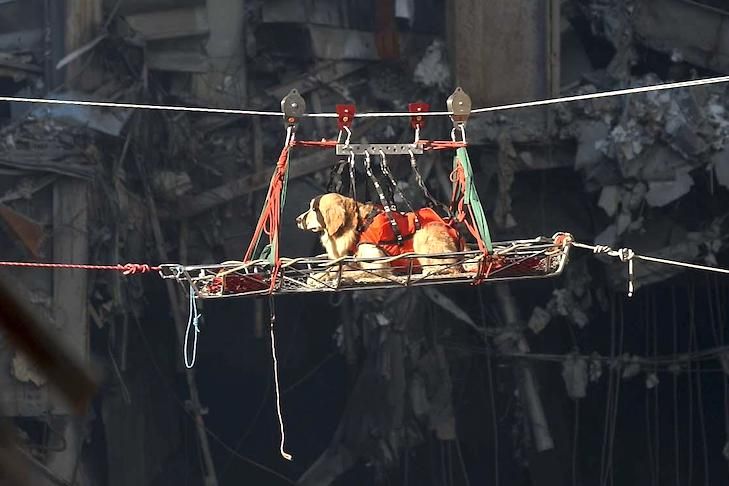Inspiring stories of rescue and therapy dogs on 9/11
To commemorate the 19th anniversary of 9/11, we share a few touching tales of some of the heroic dogs that saved lives and comforted many first responders.
Today marks the 19th anniversary of what many believe to be the most tragic day in American history. This year, along with honoring and remembering the fallen, we recognize the brave search-and-rescue and therapy dogs—German shepherds, golden and Labrador retrievers, and a rat terrier among them—that helped locate survivors and casualties and provide much needed comfort to first responders on the fateful day.
Apollo (Image courtesy of the American Kennel Club)

Apollo
Apollo, who worked with the first NYPD K-9 Urban Research and Rescue team, arrived on the scene in New York with his handler Peter Davis 15 minutes after the South Tower collapsed, according to the American Kennel Club. For weeks, Apollo and Davis worked 18-hour days searching for survivors. Apollo earned one of the first American Kennel Club Humane Fund Awards for Canine Excellence and the Dickin Medal, which acknowledged 9/11 search and rescue dogs.
Nikie
According to a 9/11 Memorial and Museum blog article, Ground Zero therapy dog Nikie comforted first responders and others searching through the wreckage of downed buildings, remaining at the site until the debris was cleared. Certified trauma responder Frank Shane, who worked with the dog, believes Nikie’s presence helped alleviate the emotional burden of those working at Ground Zero.
Riley (Image courtesy of the American Kennel Club)

Riley
One of the most well-known search-and-rescue dogs of 9/11 is Riley. Iconic photos of Riley as he was lifted out of the World Trade Center debris served as an inspiration and a sign of hope for many firefighters and police officers. The images of Riley also prompted a study of the long-term effects of rigorous search and rescue work on these brave dogs.
Ricky
The smallest search-and-rescue dog at Ground Zero was Ricky, a rat terrier that stood just 17 inches tall, according to The Seattle Times. Because of his size, Ricky could search areas that other dogs couldn’t reach. He looked for victims for 10 days straight and recovered several bodies.
Trakr (Image courtesy of the American Kennel Club)

Trakr
Canadian police officer and handler James Symington and Trakr are credited with finding the last remaining survivor of the World Trade Center attack. After 2 days at Ground Zero, Trakr was treated for exhaustion, smoke inhalation, and burns; then he was sent back to Canada. In 2011, Time magazine named Trakr one of the Top 10 Heroic Animals.
Bretagne (Image courtesy of the American Kennel Club)

Bretagne
According to the American Kennel Club, Bretagne was the longest-surviving search-and-rescue dog to have worked at Ground Zero. After 9/11, Bretagne and her owner-handler Denis Corliss worked 12-hour shifts for 10 days straight. Bretagne retired at age 9 and passed away in 2016 at age 16.
Sirius (Image courtesy of the 9/11 Memorial and Museum)

Sirius
The only dog known to have died on 9/11 was Sirius, a yellow Lab that worked below the South Tower with his handler, Port Authority Police Lieutenant David Lim. When Lim felt a violent shake in the tower, he secured Sirius in his kennel so he could help anyone who may have been injured. Unfortunately, he was unable to come back for Sirius, who perished when the South Tower collapsed. In 2002, the dog's remains were discovered amid the debris. This heroic dog received a ceremonious removal from Ground Zero complete with a full honor guard.
Thank you
Approximately 300 search and rescue dogs responded to 9/11, only about 100 of which were prepared for a disaster of this magnitude. As our country remembers the many victims of this horrific event, let’s remember the veterinarians, search-and-rescue dogs, and therapy dogs who worked tirelessly to help first responders, find victims and survivors, and offer solace and hope to a grieving nation.